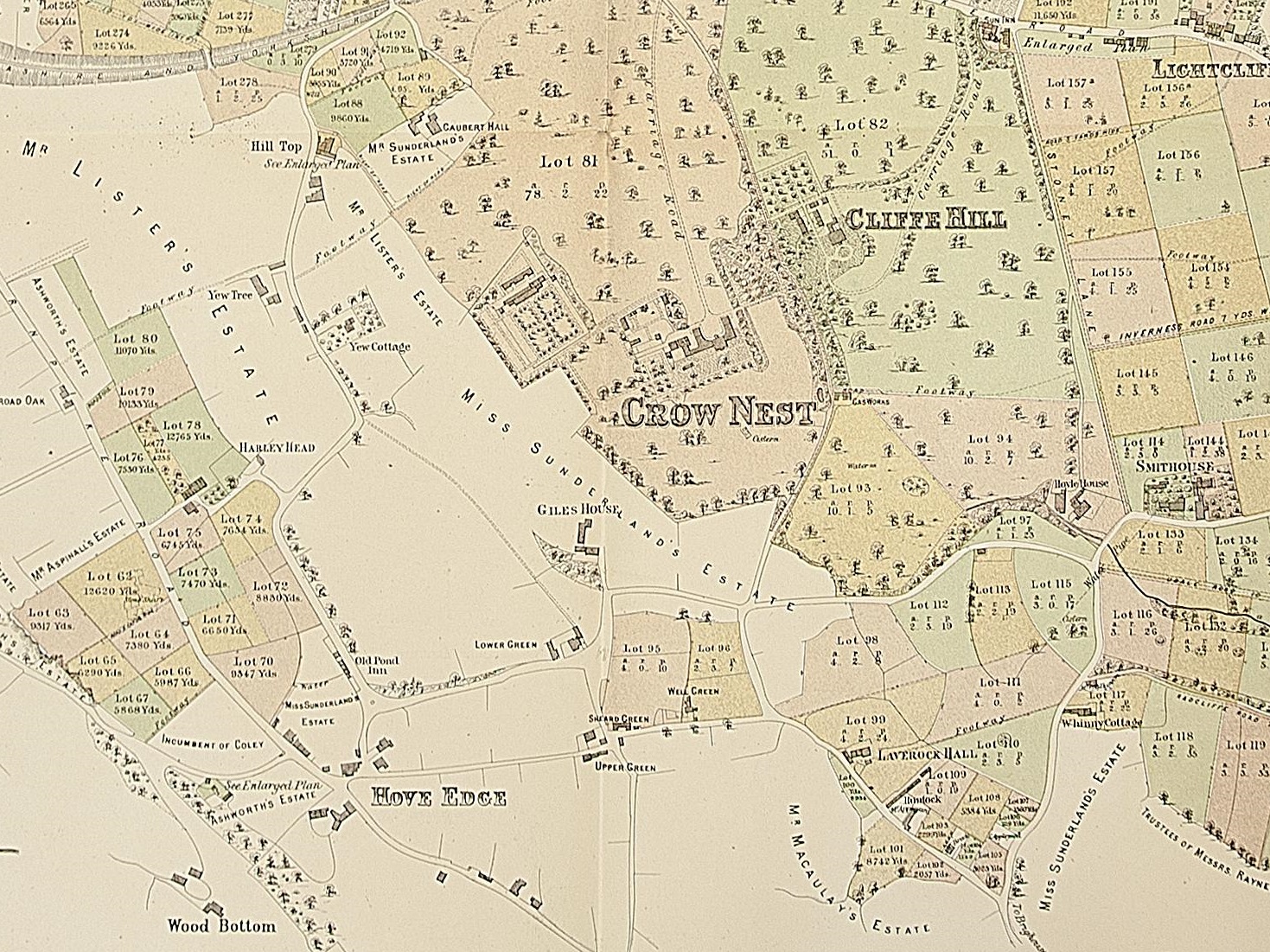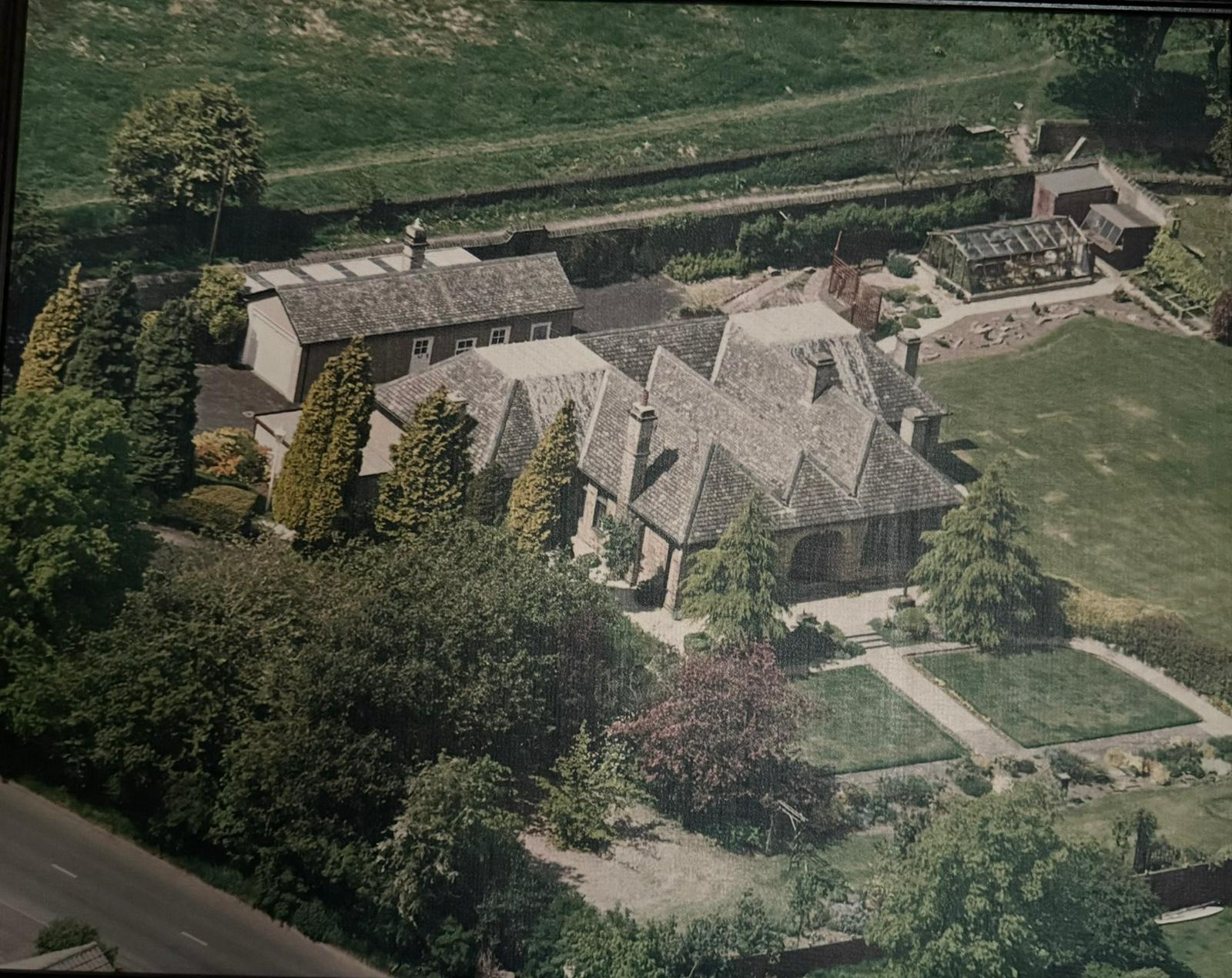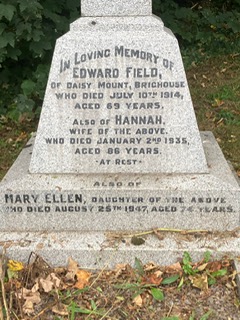The sale of some land in Hove Edge and Hipperholme belonging to the Sunderlands (of Coley) in 1875.
This article looks at the sale of land in Hove Edge and Hipperholme in 1875. It includes Giles House, Lower Green Farm and the Dusty Miller. Part of the area was known as Fold End, being the area around the start of Upper Green Lane. We do have a technical issue which currently restricts the number of photos which we can include in this article. You can see a different version by following this link, https://www.lightcliffechurchyard.org.uk/attachments/article/184/Lower%20Green%20sale%20article.pdf
There was also land at the Brighouse end of Smith House Lane. Finally, in a different transaction, an attempt to lease plots for six villas on what subsequently became The Avenue.
The principal house was Giles House. William Macaulay, who owned property to the south of Upper Green Lane including Slead Hall, sold the house in January 1844 to the Misses Sarah & Martha Sunderland of Coley Hall. Their initials and this date are carved on the keystone of an arched gateway at the southeast corner of the house.
On the plan for the sale of the Crow Nest estate by Evan Charles Sutherland Walker in 1867, a piece of land is shown as belonging to Miss Sunderland’s Estate. It stretches from part of the Lister estate to the northwest near Yew Cottage, the Crow Nest estate to the northeast, St Giles Road and Spout House Lane to the west and more land belonging to Sutherland Walker to the south. This large piece of land included both Giles House and Lower Green Farm.
What I have not yet found out is whether all of this land was originally owned by the Macaulay family or whether it had been in the hands of the Sunderlands but excluding Giles House.

Sarah Sunderland died Feb 18th1862 and left her part of the estate (in the occupation of Daniel Carter) to her brother James & her nephew Thomas Lister Joseph and niece Mary Ann Sunderland. James who died March 23rd 1863 was buried at Coley as was Mary Ann who died January 9th 1868. The heirs’ rights to sell had to be established by the High Court of Chancery. This resulted in the October, 1875 Sale of the land. One of the heirs, Thomas Joseph Sunderland lived at Acacia, Guiseley/Rawdon – a property that was previously owned by Henry William Ripley (of Holme House) at his marriage to Susan Milligan in 1836.
The sale1, conducted by Mr Jo. Shoesmith of Messrs Davis & Shoesmith, was held at The Royal Hotel, Brighouse on Wednesday, 6th October, 1875 at 4pm. There were two distinct sales within the auction with a combined plan but separate lots with their descriptions. One set is for the Giles House Estate and the other estate is termed Lower Green. Hence on the plan there are two Lot 1s and so on. Careful reading is required but areas in square yards are stipulated on both plan and catalogue which makes it easier. Further details were available from the Auctioneers, a London firm of solicitors and Messrs. Horsfall, Wardle, Patchett, surveyors and land agents of Halifax.
The plan shows a series of proposed new roads dividing up both estates with plots suitable for houses. Although these roads were never built it might have encouraged local landowners to purchase so that building was not possible.
Before the auction began, T. B. Chambers, solicitor, read the stipulations and conditions of sale having first indicated that the sale came under ‘In Chancery, In the matter of Settled Estates Acts, In the matter of the Joint Settled Estates of Sarah and Martha Sunderland’.
Within the documentation are references to the detail of title. Hence, for Lower Green, title begins with the late Joseph Sunderland Esq in April 1809 and that for Giles House estate from Arthur Macaulay’s sale to Sarah & Martha Sunderland in January 1844.
Amongst the conditions were details of the purchasers to establish roads, footpaths and drainage.
The sale was reported in the Brighouse News, 9th October 1875. The copy of the sale brochure is annotated giving a cross check on the individual sales.

The Giles House estate.
Lots 1 to 10 were all purchased by Sir Titus Salt** being situated along the southern edge of his Crow Nest Park estate for £3,190. He also bought Lots 24 to 32 for £3,140. Again, these bordered his estate lying behind Giles House. It could well have been that this was a chance to both enlarge his estate and to control any new building.
Titus Salt (1803-1876) was a textile magnate known for the creation of Saltaire village built around his mill in Shipley. He rented Crow Nest Mansion from 1848 to 1854 and then bought it from Evan Charles Sutherland Walker in 1867.
Giles House itself was described as farmhouse, barn, mistal, outbuildings and garden was bought by Richard Kershaw for £1750. He also bought several plots surrounding the house for £1300.
Giles House is a listed building [Reference 1300213] dated 1655. The story of the house can be found on the churchyard website *under The Carters of Giles House.pdf (lightcliffechurchyard.org.uk)


Lots 1& 2 are at the end of Coach Road and on Catherine Slack and adjoined Lot 93 of the 1867 Crow Nest sale which was bought by Titus Salt. A few years later all of this land was owned by Richard Kershaw and, for a period of time, Ashville House was standing there before being further developed.

There was no building on any of this land until after 1905 with houses shown on Jerry Lane (now Newton Park) on the 1931 OS map.
Richard Kershaw** (1832 – 1917) was a well-known local textile manufacturer owning Woodvale Silk Mill at Thornhill Briggs and was Mayor of Brighouse from 1895 to 1898. He owned a wide range of property including Crow Nest Mansion which he bought after the death of Sir Titus Salt.
Lot 23, which coincides with Brighouse Town football field today, was bought by a Mr Westwood for £418, it was one of the larger plots at 5570 square yards. This could be Henry Westwood described as a farmer and stone merchant in a Halifax Courier report (1868) of an enquiry into the application of the Local Government Act.
A number of lots based around the triangle of land at the corner of Upper Green Lane and the main road were bought by James Shepherd ‘of Lower Brear’ for £2,200. This included the Dusty Miller and the various buildings to the south of the pub (lot 37, £1800). James Shepherd part owned Lower Brear Brewery which was on the A58 by Lower Brear House and the modern two shops. His partner was James Alderson who may have been involved in these purchases. This is marked ‘Fold End’ on the plan.
Lot 37 was described as ‘all that Old Licenced Public-House called the Dusty Miller Inn, with stabling and outbuildings, also Two Cottages, Barn, Mistal and Garden thereto adjoining, having a frontage to the Brighouse and Denholme Gate Road and to an intended street …’ It was in the occupation of Messrs Samuel Webster and Sons or their undertenants on a yearly tenancy of £28. (Websters was a well-known Halifax brewery)
His purchase also included the land (Lot 38) where Zion Methodist Free Chapel was built six years later. (closed 1975, demolished 1976, Chapel Street.)
Lots 33 & 34, alongside Spout House Lane, did not include the Old Pond Inn or the old cottages which did not belong to the estate or, at least, were not part of the sale. Lot 33 was bought by Mr Rodgers of Walton Street Bradford (£267, 4,000 square yards)
Lot 39, a building plot on the corner of Upper Green was bought by a Mr Barber for £240 and the adjoining lot by Mr W H Dean of Southowram for £200.
Lots 44 to 49 were to be found to the eastern side of Smith House Lane and Brighouse Cemetery. These were bought by Mr William Kershaw and Mr Edward Field for a total of £1,805. The final plot, on the corner of Smith House Lane and Laverack Lane was bought by Mr Field for £400. Mr Kershaw is described as ‘of Granny Hall’.
Edward Field (1845 – 1914) was the son of William and Helen Field of Bonegate, Brighouse. His father was described in both the 1851 & 1861 Census as a proprietor of houses which may indicate why Edward was buying these plots of land. By 1881 he was described as commercial clerk in the cotton industry living at Daisy Mount on Lightcliffe Road. This house was built on lot 50 in 1875. 
In 1911, the Brighouse News reports that he was granted planning permission for a planned estate off Smith House Lane. In his will he left the majority of £7,823 (gross) in trust to his wife and daughter. When he died, he was buried at bottom of his garden – in Brighouse Cemetery.
Lower Green estate.
The first few lots, 1-7, were relatively small and were bought by Richard Kershaw as they bordered his new Giles House estate. They are described as having a frontage to a proposed carriage drive. This was never built but there is a right of way there, Grassy Lane.
Lot 8 is described as a farmhouse, barn, mistal, cottages, outbuildings, gardens called ‘Lower Green’. The house still stands and is listed. [Reference:1183935] It is dated as late C17 or early C18 with C19 alterations. There is a lintel dated IW 1722 and a fireplace dated IWD 1707. ***



Not much else seems to be known about the history of the house. There are several burial records at St Matthew’s, Lightcliffe, which refer to Lower Green but this could relate to an owner, a tenant, servant or people living in adjacent cottages. The most likely owners or principal tenants are possibly those who could afford carved gravestones and these include two Richard Flathers who died in 1718 and 1719 and a Blackburn family consisting of John who died in 1901, his two wives and two daughters who died between 1854 and 1888.
The lots 9 – 40 are all offered as building plots lying between Green Lane and Spout House Lane. There is no indication that these were bought at the sale. Looking at OS maps and the area itself, no houses were built on much of this land until relatively recently.
The Avenue.
What is now The Avenue, was shown on the Crow Nest Sale (1867) plan as belonging to the estate of Mr Sunderland. It lay between the Leeds Whitehall Road and Bramley Lane and bordered to the west by land owned by Mr Pollard and on the east by land held in trust for Hipperholme Grammar School.
It was advertised in the Bradford Observer in 1866 as being to let as building plots for villa residences.


It appears at a sale2 in 1872 as 12 building plots on either side of a proposed road together with a final lot of land containing stone. This belongs to Mr Jonathan Pollard and is situated between the Brighouse Denholmegate Road and Common Wood. It had been in the Crow Nest Sale (Lots 10 & 11) as part of the Holdsworth Farm. Either this was a combined sale between the Sunderland estate and Mr Pollard or he had bought it between 1866 and 1872?

From the deeds of one of the current properties, it looks as though Newton Brooke had bought the land by January 1903. He died in 1935 and later references on the deeds are to his sons, John & William. There are no houses showing on OS maps prior to 1930 at which stage four plots at the bottom end are shown as having houses on them.
1 WYC 1593/11
2WYC 1593/10
* https://www.lightcliffechurchyard.org.uk/about-churchyard/people-of-interest
**Calderdale Companion has details on Sir Titus Salt and Richard Kershaw.
*** Lower Green House is currently on the market (August 2024) at £750,000 with Reloc8 estate agents. The fireplace inscription image is lifted from their sales information.
Thanks to Chris Helme & Dorothy Barker. Also to Charles Bancroft, Paul Wormwell and Ian Black for sight of their Title Deeds and other information.
Ian Philp, September 2024.
